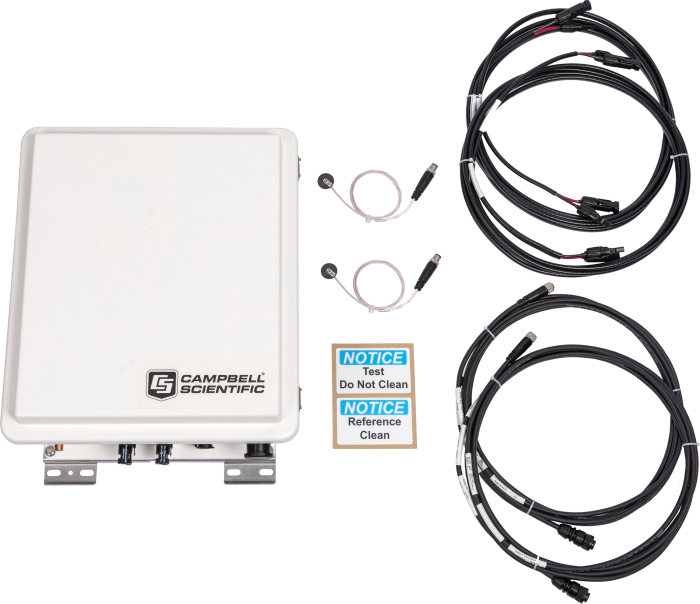Overview
The DustVue™ Solar-Module Soiling Sensor measures and calculates the soiling-loss index to provide solar energy professionals with the information needed to evaluate and manage the impact of soiling on their photovoltaic (PV) power plant performance.
The DustVue has been designed with ease of use in mind and can be used on any PV installation. The sensor includes the following:
- Measurements provided by the CS241 Back-of-Module Temperature Sensor, which has been optimized for bifacial panels
- Prewired connectors for module temperature measurements and solar panels used for the soiling measurement
- Modbus TCP communications with a standard Modbus register map
- Data filtering to maximize accuracy
- Backup battery and storage of historic data
Available options:
- Wide-ranging options to mount an electronics enclosure
- Purpose-built sensors for silicon-cell or thin-film solar panels
- Solar panels supplied by Campbell Scientific
This sensor joins our extensive line of high-quality, turn-key measurement solutions for solar and other renewable energy applications. Campbell Scientific measurement solutions provide PV performance engineers with the data needed to validate performance models and determine energy yield.
Note: The DustVue was formerly known as the SMP100 and DustSens.
Read MoreBenefits and Features
- IEC 61724-compliant soiling measurement methodology
- Real-time and daily soiling-loss index
- CS241 Back-of-Module Temperature Sensor measurements
- Factory testing of all sensors
- Quick-connect fittings for temperature and solar panel connections
- Data filtering with daily soiling-loss index caculated from qualified data points
- Modbus, DNP 3.0, and other internet protocols
- Quick-deploy guide for ease of installation
Images




Detailed Description
Soiling diminishes the output of photovoltaic (PV) module power because of dirt, snow, or other contaminants accumulating on the panel surface. This has become one of the most important operational issues of solar energy power plant performance.
The DustVue calculates soiling loss by comparing the effective irradiance from a test PV module—left to soil at a natural rate—to that of a clean reference PV module. Effective irradiance of each module is calculated in accordance with IEC 60904 by using the measured short-circuit current and back-of-module temperature to calculate effective irradiance. The effective irradiance is then used to determine the real-time soiling ratio. Daily values for the soiling-loss index are also calculated and reported, along with a quality factor for quality control purposes. In comparison, calculating soiling loss using maximum power, another IEC 61724 soiling measurement method, requires a strong dependance on cell temperature. This can result in back-of-module temperature uncertainty manifesting a higher uncertainty for soiling measurements, making it less reliable than the short-circuit method.
Several factors should be considered when selecting the two PV reference devices used to monitor soiling loss. The dynamics of dust adhesion on a PV module surface is a complex phenomenon that is affected by the local climate, the properties of the glass surface, and any coating it may have. Hence, the best soiling measurement is obtained when the PV modules used are the same make and model as those used on the PV power plant. Campbell Scientific strongly suggests using PV modules matching those deployed for power production at the site, but a customized solution can be provided if this is not possible. Additionally, the PV modules used to monitor soiling loss should ideally be mounted on the same racking as the rest of the string while not being tied into the string leading to the inverter.
The DustVue Solar-Module Soiling Sensor supports Modbus TCP and can optionally support additional communication protocols such as DNP3, PakBus, PakBus encryption, and several internet protocols.
The DustVue is delivered field ready and requires no programming to make deployment and configuration a simple process. This sensor will work with almost any user-supplied solar module. Two highly accurate and rugged back-of-module temperature sensors are also included.
Raw values of all measured quantities are stored locally on the DustVue in a data file that can be retrieved and used for further analysis or debugging. Data used in calculating the daily soiling-loss index are filtered to avoid any influences that could cause irregularities in the data sets, such as angle-of-incidence effects from incoming irradiance at low sun angles.
Some projects provide soiling-loss monitoring on production racking, and they use test and reference PV modules of the same make and model as the production panels. In these situations, Campbell Scientific integrates back-of-module temperature sensors and a pre-programed data logger into an environmental enclosure to connect and measure user-supplied PV modules. For projects that cannot provide their own panels, Campbell Scientific will provide the same hardware, along with two 20-W solar panels on a single assembly as the two PV devices for soiling monitoring. Mounting of the panel assembly will need to be determined on a case-by-case basis.
The operation of the soiling station is straightforward and requires a manual cleaning of the reference module at a regular interval, usually cleaned at the same time as the on-site pyranometer(s).
Documents
Videos & Tutorials
Frequently Asked Questions
Number of FAQs related to DustVue: 6
Expand AllCollapse All
-
Yes. When you are ready to order your DustVue sensor, be sure to request a system that is designed for use with thin-film solar panels.
-
No. The DustVue sensor must be powered from an independent DC power source.
-
The DustVue sensor already includes a data logger that can be connected directly to SCADA via Modbus TCP. An additional data logger is not necessary.
-
Yes. However, two bifacial panels should be used, and identical ground cover should be maintained behind the solar panels.
-
The clean reference panel used in the soiling measurement must be maintained on a regular basis as dictated by site conditions. Campbell Scientific recommends cleaning the reference panel at the same frequency as the pyranometer(s) at the site.
-
No. The user will need to supply production solar panels (or purchase them from Campbell Scientific) and allow for space on the mounting structure to accommodate the panels.








